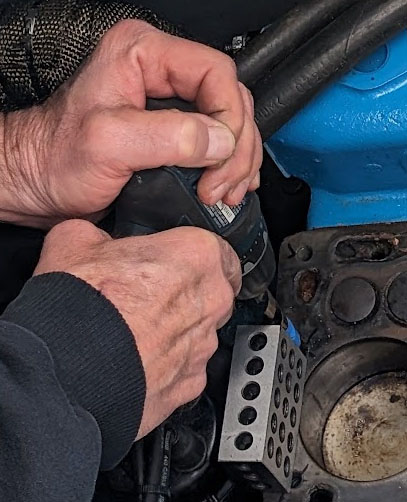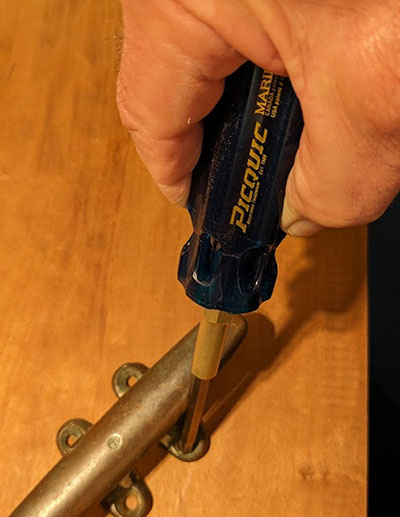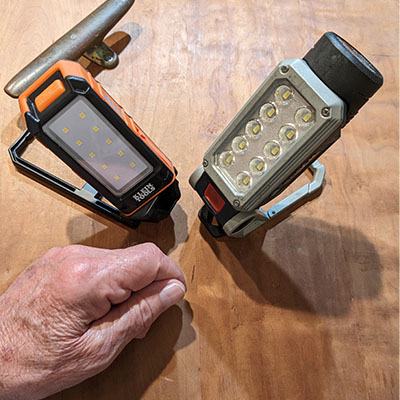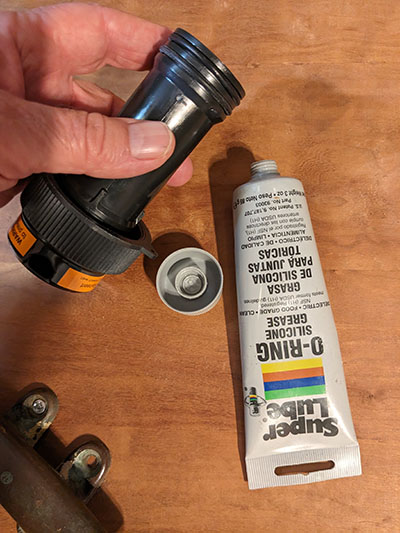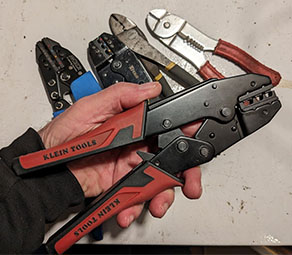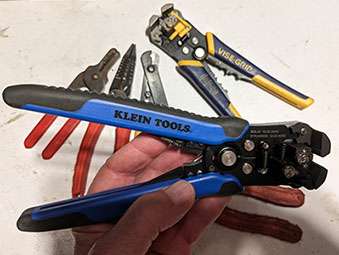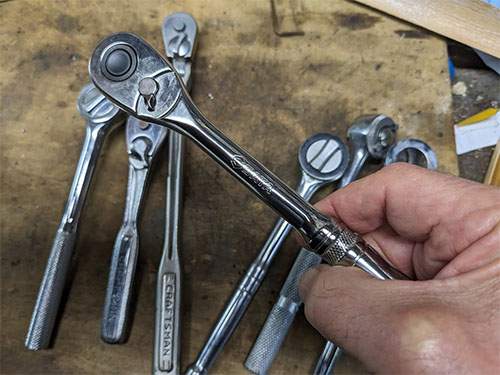Welcome to L-36.com
Your source for all things sailing and marine
Featured
L-36.com's popular Weather & Tide tool compiles all the information you need to prepare for your next (or current) marine adventure. Check it out if you have not already or enjoy the NEW article below.
Seven Great Boating Tools
Over the last four decades as a wooden sailboat owner, I've purchased and tested countless tools for maintaining my boat. Among them, the 7 products listed below stand out as my favorites. I use these regularly and have frequently recommended them to friends over the years. The images included feature the actual tools I own; if you see a hand in a picture, it's mine.
You can click on the links throughout this article for more details or to check current pricing. These are affiliate links, which means I may earn a small commission (at no extra cost to you) if you decide to make a purchase through them. Thank you for your support-it helps me keep sharing my experiences and advice!
Bosch 12 Volt Drill Driver
I bought my first 12 volt Bosch Drill Driver more than 10 years ago. I now have three drill drivers, one shorter drivers, and one impact driver. In addition I have several other Bosch 12 volt tools. If I used a drill all day like my shipwright does, I would probably get one of the 18 volt versions but I don't. I use them quite often but only charge them infrequently. When I go to do a big job on my boat I will take an extra battery but rarely have to use it. At this point I have so many chargers that I leave one on the boat just in case. I may have used it once or twice.
The clutch is adjustable starting with a very light setting that I can resist with just hand pressure on a bit. There are 20 driver settings. I generally do not use the 20 setting, it is just too strong. Above the 20 setting is the drill setting. If a drill bites in metal on the drill setting, it gives you a good jerk on the handle but it does not break the drill bit, unlike another drill I have (don't ask how I know). I use the 5 setting when screwing on the cover of waterproof plastic boxs and the 10 setting for bolting hardware to my mast aluminum.
I have had no reliability issues in the more than 10 years I have owned these tools. I have never replaced a battery. I love that they are so much lighter than the big brother 18 volt versions. I have had no problems feeling they were not up to the job. One of the last jobs I used it for was drilling out my engine block to install half a dozen HeliCoils. This involved drilling each hole more than once with increasing size drill bits. I did not have a problem and I did not break any bits. The picture above is from that day. I used the 123 block for aligning the drill bit to the engine block.
Marine Grade Multi Blade Screwdriver
In December 2017, I purchased a Mariner screwdriver and I liked it so much that I bought a second one a month later, one for my boat and one for home. The included bits fit most screws I encounter while working on my boat and can also be used with a separate drill driver. Impressively, even after over six years in a marine environment, the bits haven't shown any signs of rust, unlike some other tools I own!
Picquic makes a variety of models. The Mariner is unique in that it does not rust even in a marine environment. The bits are also a standard 1/4 inch size, which allows them to include a P3 Phillips head, a crucial bit for fasteners on large hardware like winches. I also have flat head screws on my boat and the Mariner has full 1/4 inch flat head bits. There are three sizes of flat head, P1, P2, and P3 Phillips, and an R2 square drive. For comparison, a smaller Picquic model I own uses 3/16-inch bits, which lack the P3 or large flat head sizes.
The handle stores six bits, which can be easily ejected using the active bit. This secure storage minimizes the risk of losing them. I find these bits particularly versatile: I use them in the handle, with a drill driver, and even on their own for delicate tasks due to their 3-inch length, which provides a good grip. This length can also be advantageous when using them in a drill driver, sometimes eliminating the need for an extension and avoiding situations where the extension's width might cause problems.
I like these so much I went a bit crazy when up in Bellingham at LFS Marine. I bought three additional sets of bits, torx, Allen drive, and flat head. There were 6 each of the first two and four of the flat head.
Overall, I'm incredibly impressed with the Mariner screwdriver. Its durability, versatility, and well-chosen bit selection make it a valuable asset on any boat.
Portable Work Light
I purchased the Bosch Worklight in October of 2016. I love it. I love it at home and I love it on the boat but it can't be two places at once. When I saw the Klein Worklight I had to get it. It is cheaper plus the Bosch doesn't come with a battery. That is not a problem for me because I have extra batteries but it might be for you. Including the cost of the battery, the Bosch light is twice the price and twice the weight. Both of those were a concern for a light I carry in my "boat bucket" every time I go to the boat.
The two are similar in brightness. I say similar because I would judge the Bosch as slightly brighter but the specifications say the opposite. The run times are similar as well, 6 and 9 hours. While I have I have run my Bosch light for several hours straight and never exhausted the battery doing so, it wasn't 6 hours, so I can say for sure. What I can say for sure is that they last long enough for anything I would need them for. The Klein has a LED gauge to show charge state. The Bosch battery can be tested in a drill driver but there is no charge indicator in the worklight. I just carry an extra battery if I am concerned about how much charge is left.
The other big difference is that the Bosch needs an external charger and the Klein charges with a mini USB cable. A side benefit I doubt I will ever need is that you can use the Klein as a power pack to charge a cell phone if you have your cable. The Bosch's external charger offers a significant advantage in charging speed. Fortunately, I have a charger on my boat, so if needed, I can simply take a break and let the fast charger do its job.
In terms of features, both have carabiner hooks for hanging and magnetic bases for attaching to metal surfaces (though neither will stick to stainless steel). The Klein's rotating head might offer a touch more versatility, but I wouldn't consider it a major advantage. They're quite comparable in features overall, with the exception of the Klein's dimmable mode versus the Bosch's simple on/off switch. The Bosch certainly has a more rugged look and feel compared to the Klein's lighter plastic construction. While I can't speak to their long-term durability yet, their build quality seems similar.
Overall, I'd give a slight nod to the Klein, with the caveat that I haven't had extensive use with it yet. It performed admirably when I needed it, and the lower price point for similar performance is appealing. The Bosch, on the other hand, is a reliable workhorse that's served me well for years. If you're already invested in the Bosch ecosystem and have extra batteries, it remains a solid choice. Ultimately, either light is a handy tool for illuminating those dark corners and crannies while working on boat projects.
O-Ring Grease
I bought a tube of Super Lube O-Ring Grease in March of 2023. While relatively expensive because O-Ring grease needs to be silicon based, it will last the rest of my life. (The standard Super Lube grease is a synthetic.) As of today, Amazon doesn't carry the tube version that I bought. They do have this version that is probably just fine and about half the price of what I paid.
I use it on my log senders. Yes, I have two, one on each side of the keel. One reads higher depending on which tack I am on so I average them. At low speeds, below a knot, only one works and in that case I use it. But that is a different story. The log senders are removed after every sail. Taking them in and out is so much easier since I got the Super Lube O-Ring grease. This page shows all the versions so you can see if they have it in the size I got or get a different version.
Not to be left out, standard Super Lube grease is also great stuff. I use it on my winches and backstay adjuster. I use the dry film spray version on all my blocks. I highly recommend both of these and have used both for more than 10 years. I bought Super Lube synthetic grease in March of 2012 and both the dry film and the spray lube versions in November of 2015 as well as many earlier and later dates.
Wire stripper and Crimper
Nothing is more frustrating than taking several tries to get the stripper to take off the desired length of insulation only to have the wire pull out during the final pull test after crimping. It wastes time and materials. As you might notice from the photos, I have a lot of wire strippers and crimpers. That experience was way too common with most of them. I solved both these issues when I bought this set from Klein.
The biggest issue by far with many wire crimpers is having the crimp fail on testing. My old crimper failed so often even after adjusting the tension all the way up that I took to crimping on the next smaller die. For instance, I'd crimp a blue eyelet with the red die. It got so bad I decided in 2020 to purchase the "top of the line", Ancor crimper. I found it almost impossible to use and had just as bad luck with crimps failing their pull test. I relegated it to being a second crimp on top of the main crimper to try and get it to hold. Ultimately I went for the blue on red and gave up on the Ancor. The Klein crimper has been a dream. The crimps hold and I have not even had to adjust the tension. As a bonus, it costs almost exactly half of the Ancor.
I purchased the Klein set in January 2023 so I can't speak to its durability. I bought the set but you can also get just the crimper. It is hard to resist the set as adding the stripper doesn't add much to the cost.
The stripper is a big step up from the Irwin I was using. I particularly like the positive stop on the Klein. So many times I would strip the wrong length with the Irwin because the stop would move. The Klein Stripper strips the amount of wire I want to strip.
A Nice 3/8 inch Ratchet
I bought this SATA Ratchet in September of 2022 after watching a YouTube video on Project Farm. It was not the best ratchet tested and not the cheapest but it scored A or A- on every test. The winning ratchet was the Gear Wrench which scored A+ on every test but was quite a bit more money and I already had several 3/8 ratchets as you can see. (Note: As I write this, the Gear Wrench is not available on Amazon.)
For the price (less than a week's worth of beer!), the SATA offered incredible value. It's incredibly smooth, maneuvers well in tight spaces, and feels like a significant upgrade over any of my other ratchets. Earlier this year, when I replaced my boat's manifold, the SATA's smooth operation and maneuverability in tight spaces were invaluable. It helped make the job significantly easier.
NOTICE: Some pages have affiliate links to Amazon. As an Amazon Associate, I earn from qualifying purchases. Please read website Cookie, Privacy, and Disclamers by clicking HERE. To contact me click HERE. For my YouTube page click HERE
